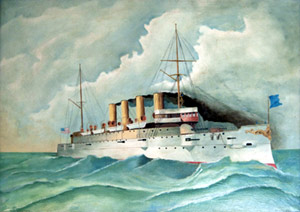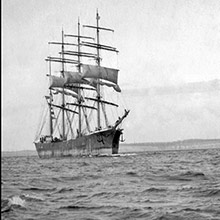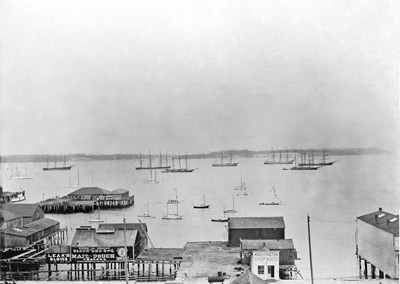MARITIME HISTORY RESOURCES AVAILABLE FOR RESEARCHERS (PDF)
Click HERE for a list of of local resources.
 In an era when sailing ships and small steam ships transported most people and goods, Port Townsend was a hub. Geographically isolated at the tip of the Quimper Peninsula on the Olympic Peninsula, Port Townsend sits at the entrance to Puget Sound, ideally situated for seafaring. Maritime-related enterprises fueled a flourishing economy, providing ready wealth and shaping the character of this ambitious town.
In an era when sailing ships and small steam ships transported most people and goods, Port Townsend was a hub. Geographically isolated at the tip of the Quimper Peninsula on the Olympic Peninsula, Port Townsend sits at the entrance to Puget Sound, ideally situated for seafaring. Maritime-related enterprises fueled a flourishing economy, providing ready wealth and shaping the character of this ambitious town.
 The U.S. government moved the Puget Sound Customs Collection District to Port Townsend in 1854, just three years after the town was founded. Every vessel entering Puget Sound from any foreign port was required to make its first stop at Port Townsend. The "Key City," as Port Townsend boosters referred to their town, was not only the home to the U.S. Customs House but also to the U.S. government-funded Marine Hospital and headquarters for the U.S. Revenue Service that operated along the Northwest coast. This predecessor to the U.S. Coast Guard sailed swift revenue cutters to enforce (more or less) the U.S. Customs and Immigration laws.
The U.S. government moved the Puget Sound Customs Collection District to Port Townsend in 1854, just three years after the town was founded. Every vessel entering Puget Sound from any foreign port was required to make its first stop at Port Townsend. The "Key City," as Port Townsend boosters referred to their town, was not only the home to the U.S. Customs House but also to the U.S. government-funded Marine Hospital and headquarters for the U.S. Revenue Service that operated along the Northwest coast. This predecessor to the U.S. Coast Guard sailed swift revenue cutters to enforce (more or less) the U.S. Customs and Immigration laws.
 By the 1880s trade ships arrived daily from all over the world, stopping for customs inspection, new crews, refitting, re-supplying and to unload and reload passengers and goods. Men looking for work or with money to spend gravitated to the bustling waterfront. Entrepreneurs of every kind followed closely behind them. Boarding houses, saloons, theaters and brothels flourished.
By the 1880s trade ships arrived daily from all over the world, stopping for customs inspection, new crews, refitting, re-supplying and to unload and reload passengers and goods. Men looking for work or with money to spend gravitated to the bustling waterfront. Entrepreneurs of every kind followed closely behind them. Boarding houses, saloons, theaters and brothels flourished.
Those who prospered built beautiful homes on the bluff above the rowdy waterfront, creating a gentrified uptown community with a separate shopping district, lovely churches, schools, clubs, a library, hospitals and parks.
 Construction boomed downtown. Large brick buildings, wharves, street improvements and public transportation were all in place. Investors built a railroad terminal and laid track as far south as Quilcene. The downtown and uptown were connected by several staircases up the bluff and both were served by the city's street cars. The money ran out before the railroad could connect to a larger line.
Construction boomed downtown. Large brick buildings, wharves, street improvements and public transportation were all in place. Investors built a railroad terminal and laid track as far south as Quilcene. The downtown and uptown were connected by several staircases up the bluff and both were served by the city's street cars. The money ran out before the railroad could connect to a larger line.
Port Townsend may have been perfectly situated for sailing ships, but steamships could proceed into Puget Sound without concern for losing the wind in the inland waterway. While Seattle and Tacoma became increasingly important ports with railroad links, Port Townsend's significance as a seaport diminished. Unhampered by reality, local citizens continued to build large civic buildings right up to 1893 and a world-wide economic depression. The loss to Seattle of the Customs Office in 1913 was a final blow to the Key City's grand ambitions.
fiveInvestors left the once bustling, boisterous, booming seaport in severe economic decline. The population steadily dwindled. In the ensuing decades, the town was largely frozen in time. While some of the grand Victorian homes and commercial buildings burned, were torn down (and recycled) or were hopelessly “remuddled,” many remain. A renaissance in the 1970s included preservation groups that began to restore the beautiful town. Today, Port Townsend is a vital and authentic Victorian seaport.